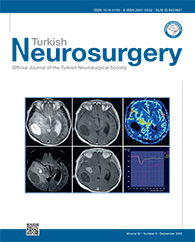2Spine Center, Seoul National University Bundang Hospital, Seoul National University College of Medicine, Department of Neurosurgery, Seongnam, South Korea DOI : 10.5137/1019-5149.JTN.37422-21.2 AIM: To conduct an animal experimental study to evaluate the safety and efficacy of the compression-resistant matrix (CRM) carrier for recombinant human bone morphogenetic protein-2 (rhBMP-2) in osteogenesis.
MATERIAL and METHODS: New moldable CRM carrier, and with rhBMP-2 (new CRM carrier with rhBMP-2) were prepared as the experimental groups. Pre-existing synthetic bone graft material was prepared as a control graft group. A total of 24 rabbits were included in the study. Defects were made and grafts were performed, and radiographic and histopathologic findings were evaluated to assess fusion.
RESULTS: In the computed tomographic scan, new bone formation was superior in 16.0%, 39.3%, 64.7%, and 81.1% of the total defect volume at 4, 8, 12, and 16 weeks in the new CRM carrier with rhBMP-2 group. In the new CRM carrier group, new bone formation was observed in 10.6%, 26.3%, 53.1%, and 71.4%, respectively. In the control graft group, new bone formation was observed in 10.1%, 26.6%, 53.4%, and 72.1%, respectively. On histopathologic evaluation, new CRM carrier with rhBMP-2 group showed better new bone formation compared with those of other groups.
CONCLUSION: The new moldable CRM carrier and the CRM carrier with rhBMP-2 showed preclinical safety and efficacy in new bone formation. In particular, the CRM carrier with rhBMP-2 was considered to be an effective bone graft material for bone fusion.
Keywords : rhBMP-2, Compression resistant matrix, Pseudarthrosis, Hydroxyapatite, Tricalcium phosphate




